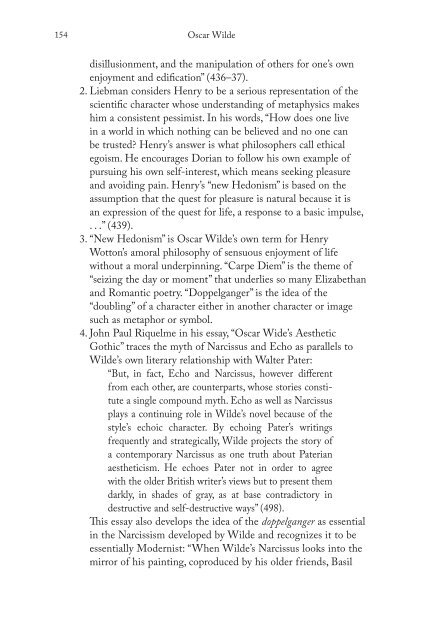Bloom's Literary Themes - ymerleksi - home
Bloom's Literary Themes - ymerleksi - home
Bloom's Literary Themes - ymerleksi - home
You also want an ePaper? Increase the reach of your titles
YUMPU automatically turns print PDFs into web optimized ePapers that Google loves.
154<br />
Oscar Wilde<br />
disillusionment, and the manipulation of others for one’s own<br />
enjoyment and edification” (436–37).<br />
2. Liebman considers Henry to be a serious representation of the<br />
scientific character whose understanding of metaphysics makes<br />
him a consistent pessimist. In his words, “How does one live<br />
in a world in which nothing can be believed and no one can<br />
be trusted? Henry’s answer is what philosophers call ethical<br />
egoism. He encourages Dorian to follow his own example of<br />
pursuing his own self-interest, which means seeking pleasure<br />
and avoiding pain. Henry’s “new Hedonism” is based on the<br />
assumption that the quest for pleasure is natural because it is<br />
an expression of the quest for life, a response to a basic impulse,<br />
. . .” (439).<br />
3. “New Hedonism” is Oscar Wilde’s own term for Henry<br />
Wotton’s amoral philosophy of sensuous enjoyment of life<br />
without a moral underpinning. “Carpe Diem” is the theme of<br />
“seizing the day or moment” that underlies so many Elizabethan<br />
and Romantic poetry. “Doppelganger” is the idea of the<br />
“doubling” of a character either in another character or image<br />
such as metaphor or symbol.<br />
4. John Paul Riquelme in his essay, “Oscar Wide’s Aesthetic<br />
Gothic” traces the myth of Narcissus and Echo as parallels to<br />
Wilde’s own literary relationship with Walter Pater:<br />
“But, in fact, Echo and Narcissus, however different<br />
from each other, are counterparts, whose stories constitute<br />
a single compound myth. Echo as well as Narcissus<br />
plays a continuing role in Wilde’s novel because of the<br />
style’s echoic character. By echoing Pater’s writings<br />
frequently and strategically, Wilde projects the story of<br />
a contemporary Narcissus as one truth about Paterian<br />
aestheticism. He echoes Pater not in order to agree<br />
with the older British writer’s views but to present them<br />
darkly, in shades of gray, as at base contradictory in<br />
destructive and self-destructive ways” (498).<br />
This essay also develops the idea of the doppelganger as essential<br />
in the Narcissism developed by Wilde and recognizes it to be<br />
essentially Modernist: “When Wilde’s Narcissus looks into the<br />
mirror of his painting, coproduced by his older friends, Basil
















